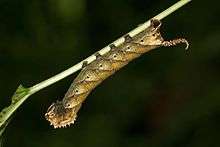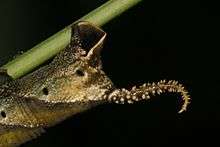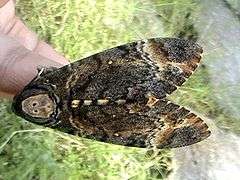Death's-head hawkmoth
| Death's-head hawkmoth | |
|---|---|
_Dorsal.jpg) | |
| Acherontia lachesis | |
| Scientific classification | |
| Kingdom: | Animalia |
| Phylum: | Arthropoda |
| Class: | Insecta |
| Order: | Lepidoptera |
| Family: | Sphingidae |
| Subfamily: | Sphinginae |
| Genus: | Acherontia Laspeyres, 1809 |
| Species | |
|
A. atropos - African death's head hawkmoth | |


The name death's-head hawkmoth refers to any one of the three moth species of the genus Acherontia (Acherontia atropos, Acherontia styx and Acherontia lachesis). The former species is found primarily in Europe, the latter two are Asian; most uses of the common name refer to the European species. These moths are easily distinguishable by the vaguely human skull-shaped pattern of markings on the thorax. All three species are fairly similar in size, coloration, and life cycle.
These moths have several unusual features. All three species have the ability to emit a loud squeak if irritated. The sound is produced by expelling air from the pharynx, often accompanied by flashing of the brightly colored abdomen in a further attempt to deter predators. All three species are commonly observed raiding beehives of different species of honey bee for honey; A. atropos only attacks colonies of the well-known Western honey bee, Apis mellifera. They can move about in hives without being disturbed because they mimic the scent of the bees.[1]
Development
Eggs are laid singly under old leaves of a host plant and are green or grey-blue. None of the three species is restricted to a single family of host plant; hosts are typically of the families Solanaceae, Verbenaceae, Oleaceae, Bignoniaceae, and others. The larvae are stout, reaching 120–130 mm, with a prominent tail horn. All three species have three larval color forms: typically, green, brown, and yellow. Larvae do not move much, and will click their mandibles or even bite if threatened. When mature, they burrow underground and excavate a small chamber where they pupate.
In popular culture
The skull-like pattern and its fanciful associations with the supernatural and evil have fostered superstitious fears of Acherontia species, particularly Acherontia atropos, perhaps because it is the most widely known. The moths' sharp, mouse-like squeaking intensify the effect. Nor is this a new attitude: during the mid 19th century entomologist Edward Newman, having earlier mentioned the mark on the thorax wrote: "However, let the cause of the noise be what it may, the effect is to produce the most superstitious feelings among the uneducated, by whom it is always regarded with feelings of awe and terror."[2]
These moths have been featured often in art such as by German artist Sulamith Wülfing, and movies such as Un Chien Andalou (by Luis Buñuel and Salvador Dalí) and The Silence of the Lambs (in the film's source novel, a different moth species is used; the Black Witch), and in the artwork of the Japanese metal band Sigh's album Hail Horror Hail. They are also mentioned in Chapter 21 of Bram Stoker's Dracula, where Dracula has been sending moths for Renfield to consume. According to legend, the species was first seen in Britain at the time of the execution of King Charles I,[3] but it is more likely to have simply become more common by that time, having arrived with the first transportation of potatoes some centuries earlier. Though rarer, it is still occasionally sighted in the country to this day.[4]
Edgar Allan Poe's short story The Sphinx[5] describes a close encounter with a death's-headed sphinx moth, describing it as "the genus Sphinx, of the family Crepuscularia of the order Lepidoptera."
The moth plays a central role in the 2015 Taiwanese horror film The Tag-Along.[6]
The species names atropos, lachesis and styx are all from Greek myth and related to death. The first refers to the member of the three Moirai who cuts the threads of life of all beings; the second to the Moira who allots the correct amount of life to a being; and the last refers to the river of the dead. In addition the genus name Acherontia is derived from Acheron, a river of Greek myth that was said to be a branch of the river Styx.
The enigmatic website Cicada 3301 uses a Death's-head hawkmoth as primary logo.
Gallery
-
Larva of Acherontia atropos
References
- ↑ Moritz, RFA, WH Kirchner and RM Crewe. 1991. Chemical camouflage of the death's head hawkmoth (Acherontia atropos L.) in honeybee colonies. Naturwissenschaften 78 (4): 179-182.
- ↑ Newman, Edward. The natural history of British butterflies and moths. Pub: William Glaisher, London, ca 1870. Downloaded from:
- ↑ Denis Larionov & Alexander Zhulin. "The New Forest: its history and its scenery by John Richard de Capel Wise, pg. 177". Ebooksread.com. Retrieved 2011-11-01.
- ↑ "'Death's Head' caterpillar found (Thursday, 14 August, 2003)". BBC News. 2003-08-14. Retrieved 2011-11-01.
- ↑ "The Sphinx- Edgar Allan Poe". Classiclit.about.com. 2009-11-02. Retrieved 2011-11-01.
- ↑ "'The Tag-Along at the Internet Movie Data Base'". Retrieved 2016-05-24.
External links
- A. atropos detailed information
- A. styx styx detailed information
- A. lachesis detailed information
- 12 Facts About Death's Head Hawkmoth

.jpg)

